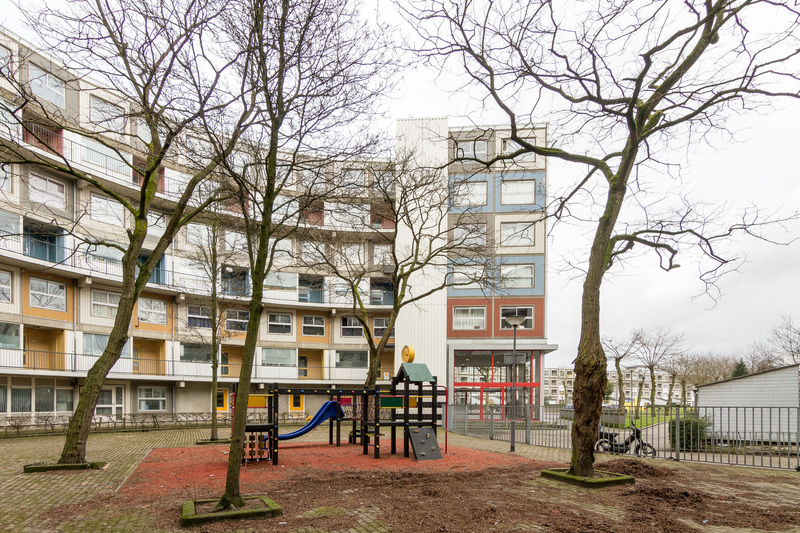Thessaloniki gets ready for its metro launch in November
The underground rapid transit lines have been under construction for almost two decades due to various project delays
 TheMayor.EU logo
TheMayor.EU logo The complex of Peperklip in Rotterdam is becoming a future-proof home to 1,300 people
The largest social housing complex in Rotterdam-Zuid has just taken yet another step towards climate resilience. The iconic Peperklip now has the longest natural roof amongst all residential buildings in the Netherlands, reported the municipality of Rotterdam earlier this week. The 7,600 square meters of greenery which will grow on the roof shall contribute to the biodiversity in the city and retain water during periods of heavy rainfall.
The green roof of Peperklip is a collaboration between the municipality and the Vestia housing association and is funded under the LIFE @ Urban Roofs project for climate action, subsidised by the EU. The roof is now given time to grow into full but once this happens there will be space for bees, butterflies and birds. The project is thus believed to contribute to the city’s ambition to become resilient to climate change.
The residential complex rents a total of 549 properties and hosts about 1,300 people. It is currently undergoing a major overhaul by Vestia, which includes maintenance and improved insulation.
Although the roof will not be accessible to the residents of the complex, it will serve them in other ways. For example, it will help regulate the building’s temperature, by cooling it in the hot summer days and insulating the indoor climate in winter. The plants on the roof will also retain water for longer, which helps prevent flooding during heavy rain.
See how it works in the video below (in Dutch):
The residential building Peperklip op Zuid in Rotterdam will soon have 7,600 square metres of greenery on its roof. Video by Municipality of Rotterdam
Alderman Bert Wijbenga, quoted by the municipal website, explained that the port city wants to create an additional 20 hectares of greenery in the city over the coming years. The green roof of Peperklip thus serves as a good example of the opportunities that roofs offer to expand greenery in urban areas, where space is scarce and which are bound to face increasing climate-resilience challenges.
Instead of being relegated as unused spaces, green roofs can combine multiple functions, such as generating sustainable energy with solar panels and social functions, such as a terrace or playground, water storage and biodiversity.
The sustainable transformation of the residential complex Peperklip goes far beyond a green roof, however. Designed by architect Carlos Weeber in the shape of an opened-out paperclip, the complex invites its inhabitants of all ages to invest themselves into the green transformation of the building.
 Peperklip shows that there is a space for greenery even in built-up areas. Photo by Resilient Rotterdam
Peperklip shows that there is a space for greenery even in built-up areas. Photo by Resilient Rotterdam
Children are encouraged to paint their views on nature and sustainability on its murals, residents who have previously struggled to find work are now working on Peperklip’s maintenance team. Energy coaches will also be available to help residents change their behaviours to make savings.
Initiatives like Peperklip serve as a good example that even in complex urban environments it is possible to design climate-resilient spaces, with smart and inclusive approaches.

The underground rapid transit lines have been under construction for almost two decades due to various project delays

Now you can get your wine in Talence by paying directly in Bitcoin

That’s because the state has to spend money on updating the railway infrastructure rather than subsidizing the cost of the popular pass

Rethinking renewable energy sources for the urban landscape

The examples, compiled by Beyond Fossil Fuels, can inform and inspire communities and entrepreneurs that still feel trepidation at the prospect of energy transition

Now you can get your wine in Talence by paying directly in Bitcoin

The 10th European Conference on Sustainable Cities and Towns (ESCT) sets the stage for stronger cooperation between the EU, national and local level to fast track Europe's transition to climate neutrality.

At least, that’s the promise made by the mayor of Paris, Anne Hidalgo

The underground rapid transit lines have been under construction for almost two decades due to various project delays

At least, that’s the promise made by the mayor of Paris, Anne Hidalgo

Hostal de Pinós is located in the geographical centre of the autonomous region

Despite its church-y name, the district has long been known as the hangout spot for the artsy crowds

Urban dwellers across the EU are having a say in making their surroundings friendlier to people and the environment.

Forests in the EU can help green the European construction industry and bolster a continent-wide push for architectural improvements.

Apply by 10 November and do your part for the transformation of European public spaces

An interview with the Mayor of a Polish city that seeks to reinvent itself

An interview with the newly elected ICLEI President and Mayor of Malmö

A conversation with the Mayor of Lisbon about the spirit and dimensions of innovation present in the Portuguese capital














